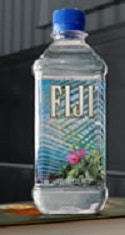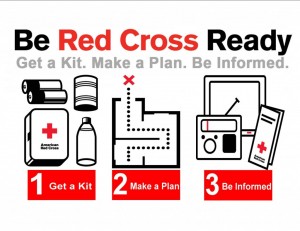Are you prepared for a natural disaster that would disrupt utilities, communication, and safety? Sadly, nearly every survey on the subject reveals that a majority of Americans are not prepared for a disaster.
FEMA and The American Red Cross have some great resources on the Internet that can help your family. The American Red Cross, in particular, has put together an online guide featuring three steps for preparing your home and family.
The three steps are:
1. Get a kit: Gather the supplies that you can use at home or take with you in case you must evacuate.
2. Make a plan: Plan what to do in case you are separated during an emergency, Plan what to do if you have to evacuate
3. Be informed: Learn what disasters or emergencies may occur in your area and make sure each family member has an Emergency Contact Card.
As someone who’s learned a great deal about shopping for supplies and getting great deals without a lot of hassle, I’d like to share some specific strategies for accomplishing step #1, getting a kit. I’ve written previously on building a pantry with three to six months of food and household supplies for your family. It’s an excellent plan to help you and your family weather a financial storm. If faced with income loss or a large unexpected expense, your food and supplies on hand will allow you to eat from your pantry freeing $500 to $1000 that you normally would have spent that month at the grocery store. A supply of this size will be a tremendously helpful resource if you and neighbors need help during the days, weeks, or months following a disaster.
The list of items you should have on hand and in your vehicle will require some shopping if you haven’t already assembled them. While the full list can be found at the American Red Cross’s website or FEMA’s Ready.gov, I want to highlight a couple of the items and how I would recommend purchasing them – starting today.
 Water
Water
The Red Cross recommends having 14 gallons for each person in your home. (One gallon each for two weeks). While you can fill thoroughly cleaned, food-safe containers with water from your tap, make sure you follow the specific safety steps for preparing and storing water. This includes adding 1/8 teaspoon (5-7 drops) of bleach to each gallon container of water in case of any lingering bacteria in the container. Do not use bleach with any extra ingredients like fragrances.
The Red Cross and FEMA recommend that you buy commercially bottled water, if possible. You can buy cases of water for $2.99 if you wait for the right sale. Just before the hot summer months are the best time to get a low price. While coupons are occasionally available, I recommend watching for a $2.99 or less price for a case and stocking up when you see it. One case (24 half-liter bottles) of water equals slightly more than three gallons. 2 1/3 cases will meet The American Red Cross’s minimum amount for each family member. You can also check with your local grocery store, but you’ll likely find a better deal per ounce if you buy three gallon containers of water. The smaller bottles may be a bit more convenient – and are very helpful if they can help you avoid buying bottles of water at restaurants and convenience stores in the meantime.
If you’ve bottled tap water it needs to be rotated every 6 months. Commercially bottled water should be rotated once a year – but check how old the water is when you buy it. Look for a “pull date” on the bottle itself or the case packaging. You don’t want to buy year-old water. Water bottles should be kept in a cool, dark place. Never store them in direct sunlight.
Your 72-hour kit
A 72-hour kit should be ready for each member of the family. One 72-hour kit should be kept in the car – and you should have one at your office – or workplace if possible. Food is just one part of a 72-hour kit; I encourage you to get the full list of items to pack a backpack for each member of your family. It’s not necessary to buy a ready-made kit – when you can put together your own kits at a fraction of the cost – ensuring that they’ll meet your needs and probable disaster scenarios.
You want foods that require no refrigeration, preparation or cooking and little or no water. Ready.gov recommends this list of foods: Ready-to-eat canned meats, fruits and vegetables, protein or fruit bars, dry cereal or granola, peanut butter, dried fruit, nuts, crackers, canned juices, non-perishable pasteurized milk, high energy foods, vitamins, food for infants, comfort/stress foods. You’ll need first aid and personal hygiene items as well. If you have a pet, don’t forget about their 3-day needs.
Almost every item on this list is regularly in our database (SavingsAngel.com) at prices 40%-100% off. Most ready-made 72-hour kits simply include high calorie protein/candy bars as their only food option for every member of the family. Take a little bit of effort and pack your kits right. Heaven forbid you should need them – but if you do, it will be nice to know that your preparations are thought out.
Regarding disaster preparation, the bottom-line is this: You’re either going to have resources for your family and you’ve done your best ahead of time to stay safe – or you’re going to rely upon others to provide these basic necessities when you can get them. You’ll actively make this decision in advance either by each day you’re prepared – or each day you put off preparedness.
– – –
The easiest way to cut your grocery bill in half is through using manufacturers coupons combined with the best sales at local stores. Normally, this takes a lot of work to create a winning shopping list for your family. Each week, SavingsAngel.com combines over 2,000 products on sale at local grocery and drug stores with their enormous database of manufacturer coupons ““ which are found in Sunday’s newspaper and throughout the Internet. This combination results in access to over 300 products each week for 50% off or better. Here are a few examples of deals that are available until Saturday at midnight. Please look for Tuesday’s column each week for tips on how you can easily start cutting your grocery bill!
This month, you can redeem a four-week free trial full-access SavingsAngel membership. We guarantee your success. Click here to start saving hundreds each month.



